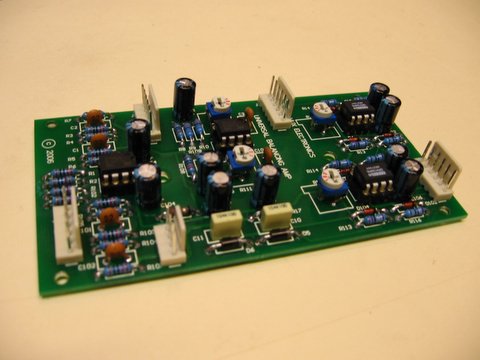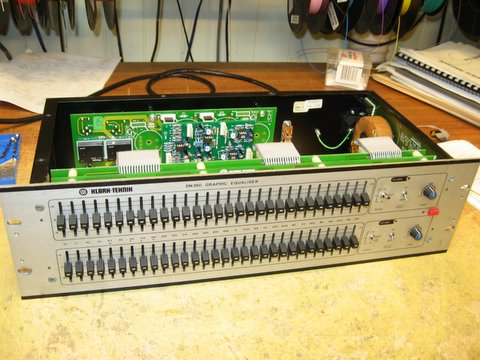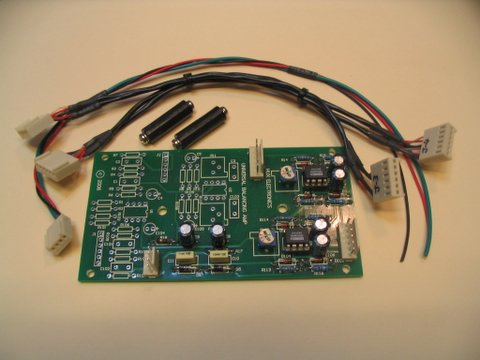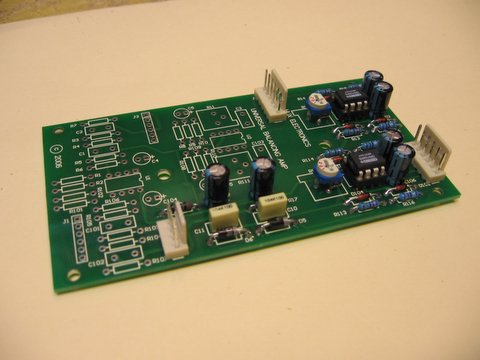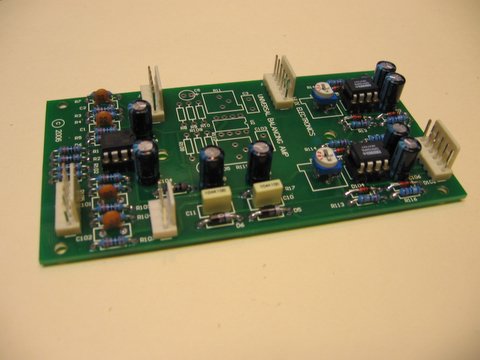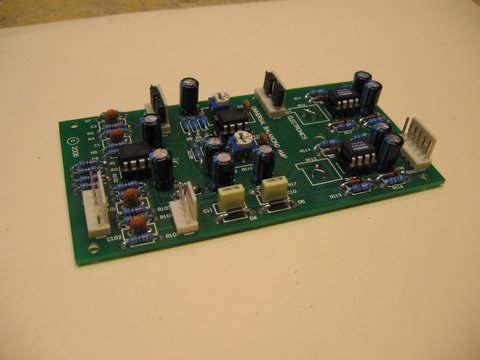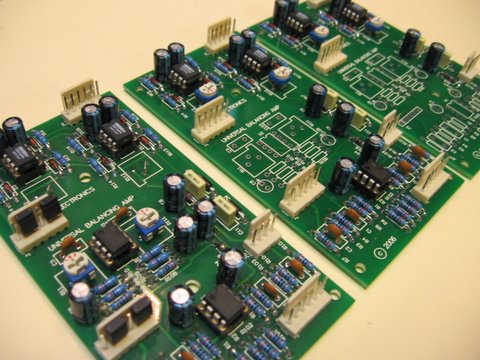Hux Universal Balancing Amplifier
The Hux Universal Balancing Amplifier system is a dual channel, flexible solution to balancing, unbalancing and summing problems. The unit can be supplied as just a PCB, as a PCB with all required components or as a fully built and tested unit with the cable sets already made. The PCB is a high quality, double sided board and is screen printed to make life a little easier.
The "unbalancing" stage uses an industry standard and robust approach. In standard form the level of the input signal is dropped by 6dB when converted from balanced to unbalanced, this ensures an identical clipping point between the balanced input and the unbalanced output with very high headroom (6dB above a unity gain option).
The "balancing" output stage uses Burr Brown DRV134 active balanced line driver devices. These devices add 6dB of gain between their inputs and outputs, this ensures an identical clipping point between the balanced input and the unbalanced output with very high headroom (6dB above a unity gain option). If desired, the gain can be reduced to unity (or any gain of less than 6dB) by the onboard trim pots. Protection has been incorporated in the balanced output stage to ensure that externally applied 48 volt phantom power cannot damage the balanced line driver devices or impair the operation of the unit.
The "balanced to unbalanced" input stage drops the level by 6dB, the "unbalanced to balanced" output stage adds 6dB of gain. If you plug the output of the "unbalancing" stage directly to the input of the "balancing" stage you then have a unity gain balanced input to balanced output amplifier with high headroom and inserts available.
An additional "vari-gain" stage has been included in the design of the Hux Universal Balancing Amplifier system. The "vari-gain" stage allows for fully variable cut of 12dB through to a boost of 12dB. It can be useful as part of a balanced input to balanced output problem solving box or simply as a way to provide extra loss to the "unbalancing" amp stage or extra boost to the "balancing" amp stage. The "vari-gain" stage can also be used as an "active summing" amplifier.
It must be noted that the "vari-gain" stage causes a phase/polarity reversal. It was decided at the design stage not to correct this problem as it would add to the component count and it is easy to fix by simply swapping the phase/polarity of balanced wiring to suit
The PCB is intended to be fitted inside "host" equipment. The PCB draws its required regulated +/- 12 to 18 volt DC supply from the "host". It is intended that Molex 0.1" connectors are used for DC and signal connection, direct solder connections can be used if preferred.
Hux Universal Balancing Amp Description (pdf)
Pricing and Options (pdf)
Circuit Diagram and Layout (pdf)
Info on the DRV134 Balanced Line Driver Chip used (pdf)
Why the output stage cant be damaged by phantom power (pdf)
Hux DN360 Balanced Output Mod for Klark Teknik DN360 Graphic EQ (pdf)
Hux DN360 Mod Installation Instructions (pdf)
Suggested Uses
((1) Stereo Balancing Amplifier Only
A typical use would be to balance the output of a source only device such as a domestic CD player. A typical domestic CD player has a peak output of 2 volts RMS (+8dBu). I suggest that the peak output for a balanced CD player should be trimmed to no more than +12dBu.(2) Stereo Unbalancing Amplifier + Stereo Balancing Amplifier
A typical use would be to balance the inputs and outputs to a record/play device such as a MD recorder or a flash-RAM recorder. The 6dB of loss at the unbalancing amplifier and 6dB of gain for the balancing amplifier are ideal for this purpose.(3) Stereo Unbalancing Amplifier (with extra loss) + Stereo Balancing Amplifier
Some domestic record/play devices have very sensitive inputs stages and more loss is required by the unbalancing stage. The output of the unbalancing amplifier can be fed into the vari-gain stage (which has a +/-12dB trim range), the combined output can then be set (with the vari-gain trim pot) between a gain of 6dB and a loss of 18dB.(4) Stereo Unbalancing Amplifier + Stereo Balancing Amplifier (with extra gain)
Some domestic record/play devices, such as cassette decks, have a low average output and more gain is required by the balancing stage. The output of the record/play device can be fed into the vari-gain stage (which has a +/-12dB trim range), the output of the vari-gain stage is fed into the balancing amplifier, the combined output can then be set (with the vari-gain trim pot) between a gain of 18dB and a loss of 6dB(5) Stereo Unity Gain Unbalancing Amplifier + Unity Gain Balancing Amplifier
A typical use would be to in/out balance an unbalanced outboard signal processor, such as a compressor/limiter, without changing the overall operating level for the device. Modify the unbalancing amplifier for unity gain by removing R4, R5, R104, R105. Adjust the balancing amplifier to unity gain with its onboard trim pots. The maximum input/output level of an unbalanced device is +22dBu and so there is a compromise in unity gain bal/unbal operation.(6) Stereo Balanced Input to Balanced Output Amplifier
Connect the outputs of the unbalancing amplifier straight to the inputs of the balancing amplifier or use the links as unbalanced insert points to insert gain control (or other).(7) Stereo Balanced Input to Stereo Balanced Output Amplifier with +/- 12dB of trim.
Fit 0.1" jumper shunts across pins 2-3 and pins 5-6 of connectors J2 and J3 and then you have a high headroom balanced in balanced out problem solving device with inserts available.(8) Klark Teknik DN360 Dual Channel Graphic Equaliser Output Balancing Amplifier
The DN360 as standard has balanced inputs and unbalanced outputs. The Universal Balancing Amplifier PCB is designed to exactly fit mounting points on the DN360 XLR in/out board. A Molex loom connects directly to connectors in the DN360, only the three power supply wires require soldering. The balancing amp trim pots are set for unity gain.(9) Stereo Active Summing Amplifier
The vari-gain stage can be used as an active summing amplifier by simply shorting out the three legs of the vari-gain trim pots, replacing R9, R109 with wire links and replacing R10, R110 with 10K resistors (or any desired value). Use in combination with the balancing and/or unbalancing stages.(10) Sum/Diff Encode or Sum/Diff Decode Amplifier : (also called M/S or Middle & Side)
With an additional op amp stage mounted on an outrigger board the Universal Balancing Amplifier can be configured as an Sum/Diff encoder device (L+R=S, 6dB loss for L or R only) or an Sum/Diff decode device (S=L&R, unity S to L or S to R). In both cases the inputs and outputs are balanced and the Sum/Diff encode or decode performance is rock solid.
PCB Layout (see "Circuit Diagram and Layout" pdf link above for a clearer view)
Klark Teknik DN360 Graphic Equaliser : Balanced Output Modification
The live sound industry standard Klark Teknik DN360 graphic equaliser has an unbalanced output. The Hux Universal Balancing Amplifier PCB is purposely designed to piggyback onto the XLR in/out PCB inside a Klark Teknik DN360 equaliser. Fitting the Hux balancing amplifier enables a cost effective and high quality balanced output option for these fine industry standard equalisers and eliminates the need for "special" insert cables. Short Molex looms are used to link between the balancing amplifier and the DN360 XLR input/output board. When mounted in the Klark Teknik DN360 equalizer only the right hand third of the Universal Balancing Amp PCB is used.
Klark Teknik DN360 Graphic Equaliser Balanced Output Mod (shows the assembled PCB, cable set and board mounts)
Balancing Amplifier Only (typical use for balancing source only devices, such as CD players etc)
Unbalancing Amplifier plus Balancing Amplifier (the most common configuration for balancing record and play devices)
Balanced Input to Balanced Output with +/-12dB of Vari-Gain (very flexible, see "suggested uses" area)
All three main versions side by side.
